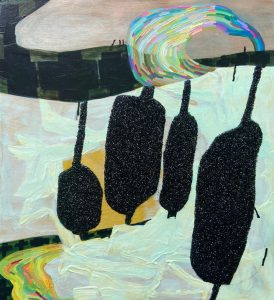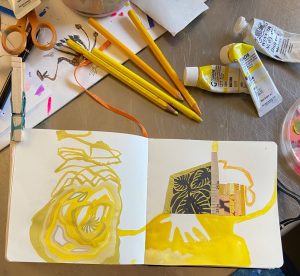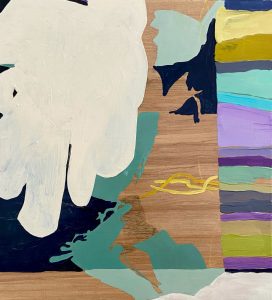
For the past six months it has been my pleasure to have artist Ingrid Ellison working in a studio at 26 Split Rock Cove. Ingrid’s own studio in Camden is getting a much needed and desired renovation and while she thought the project might only require two or three months, we all know how renovations go.
But I’m sorry to see Ingrid leave. She has worked many days a week here. That work ethic has a wonderful impact on everyone else and 26 Split Rock Cove has been buzzing in the midst of winter and our hibernation and isolation during the pandemic. Ingrid has amassed a huge body of work that can be seen this summer at Carver Hill Gallery in Camden, or at Cynthia Winings Gallery in Blue Hill, Maine. I’m looking forward to seeing this work hanging up in those galleries and I’m thrilled the galleries will be open this summer.
Last week I had a chance to sit and talk with Ingrid about her winter work.
Starting work in a new space can be daunting or even paralyzing, so Ingrid made a decision to sign up for an online drawing class with artist Deborah Zlotsky, who teaches at Rhode Island School of Design, which correlated perfectly with Ingrid’s first week in the new studio.
Ingrid has followed Zlotsky’s work for many years and finds her work inspirational. As her first assignment, she was to make 20 drawings using only one move per drawing, or in other words, making one gesture or mark per drawing and repeat it over and over as much or as little as she wanted to, and create a drawing. As she was completing the assignment, she began to understand something. Ingrid said it changed her tendency to fill the picture plane, and possibly overcrowd it. The idea resonated. That one mark, and then one more mark, and one mark more was enough to shake her process up a bit, and that set the tone of her work for the months to follow.
Ingrid continued, “The other thing that got me through the year was that I signed up for the Yellow Chair Salon” series at Truro Center for the Arts, Castle Hill, MA. “I felt like I needed some kind of check-in for being here. I just wanted to use my time really well. And sort of pushed myself toward being open to going different directions.” Yellow Chair assembles groups of artists that present work to one another and offer critique and guidance under the direction of one leader. While most in her group are painters, she says, “I’m the only person in my group who uses a brush on a panel or a canvas. People pour, or use masking. There’s no evidence of the hand.” Not at all like Ingrid.
Looking around, I asked her about a series of paintings she had just completed. “So, when I did these our mentor suggested we make a make a 3-D version of our paintings. That’s when I made that little guy,” pointing to a ladder-shaped cardboard construction which found its way into her painting. “I was sort of riffing off of those images. And the other thing was, I also made stacks of works on paper while I was here. One thing that happens when I go to using a panel or canvas as a support is that the surface begins to feel precious, and I think differently – like I am making a painting the way I always make a painting. I wanted to retain that fresh experimental quality that the works on paper have, so I cut up a sheet of birch plywood and tried to address the paintings with the immediacy of a paper surface.”
“I just sanded them. I didn’t put any finish on them at all. And I was like ‘this is a piece of paper. Don’t feel like you have to cover everything.’ So that was really liberating. I was able to let the space of the board alone in places and that discovery was important. I was able to stop. And I like them.” That, in so many words, is what the artmaking process feels like.
I asked Ingrid to tell me what was in her mind as she began these paintings. “In normal terms, I think of a color, kind of palette I want to have for the painting. It’s often something I come across on a walk or a small vignette or pile of objects I’ve collected and brought into the studio. For that one with this weird overly-yellow thing, I was thinking of those grasses (outside the studio). Those colors, I sort of attach myself to colors. And at the same time ever since we made the small 3-D maquette, I’ve been trying to find new and different shapes, because I didn’t want to fall into the habit of making a painting the way I already knew, like I didn’t want to know what exactly I was doing. Sometimes the wood grain dictated the divisions, the teal-y area depictssomething casting a shadow.
“That’s why I work with these lights. I’m obsessed with shadows. The white shape, I was just cutting out weird things. I just had a couple of these and I put them together. And I said, what if there was just one giant thing. It takes up a lot of real estate. I love playing around with how big the scale feels on some of the little pieces.”
As you can tell from this description, the process is more of an uncovering, experimenting, and realizing of things on an artist’s mind. It’s not linear, it’s definitely not decided upon ahead of time. Lots of trying things out, and finding your way. As Ingrid says, for her, “Everything is line, color and shape.”
Ingrid’s new studio is not yet ready, but she leaves on May 1. She is ready to get back to her gardens, to deliver her new work to the galleries, and to be back (hopefully) in her renovated studio in August.
Ingrid Ellison returns to 26 Split Rock Cove September 25 & 26 to teach Keeping a Visual Journal. Please check the website in mid-May to sign up for this workshop.




